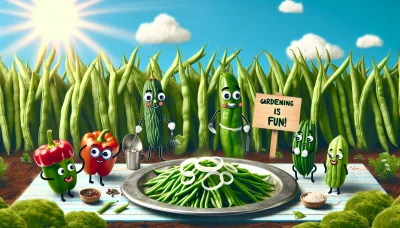How to make persimmon pulp Quiz
Test Your Knowledge
Question of
How to Make Persimmon Pulp: A Gardener's Guide
Persimmon pulp is a versatile ingredient cherished both in gardening and culinary circles for its rich nutritional profile and unique flavor. In gardening, this pulp can be used as a natural fertilizer, offering plants a hearty dose of essential nutrients. For culinary enthusiasts, persimmon pulp adds a sweet, honey-like flavor to a variety of dishes, from baked goods to smoothies, making it a coveted ingredient for those looking to add a touch of sweetness to their recipes without resorting to processed sugars. Understanding how to make and utilize persimmon pulp can thus open up a world of possibilities for gardeners and cooks alike.
Choosing the Right Persimmons
When it comes to making pulp, not all persimmons are created equal. The two main types you'll encounter are Fuyu and Hachiya. Fuyu persimmons are squat and somewhat doughnut-shaped, known for their sweetness and can be eaten raw, while Hachiya persimmons are larger, with an acorn shape, and must be fully ripe to avoid their astringent taste. For pulp, Hachiya persimmons are the preferred choice due to their soft, jelly-like texture when ripe, which makes them ideal for baking and cooking.
To select ripe persimmons for your pulp, look for fruits that are deep orange, without any green tints. The skin should be glossy and smooth, without any blemishes. Ripe Hachiya persimmons will feel soft to the touch, almost like a water balloon. If they're firm, they're not ready to eat and will need a few days to ripen at room temperature. Remember, patience is key with Hachiya persimmons, as they only reach their peak sweetness and desired texture when fully ripe.
Step-by-Step Guide to Making Persimmon Pulp
- Start by selecting ripe persimmons. They should be soft to the touch.
- Wash the persimmons thoroughly under running water to remove any dirt or debris.
- Remove the leafy tops of the persimmons with a knife.
- Cut the persimmons into quarters to make them easier to blend or process.
- Remove any seeds that you find in the fruit. Not all persimmons will have seeds, but it's good to check.
- Place the quartered persimmons into a blender or food processor.
- Blend or process the persimmons until they form a smooth puree. You may need to scrape down the sides a few times to ensure an even consistency.
- If the pulp is too thick, you can add a small amount of water to help it blend more smoothly.
- Once the persimmons are fully pureed, strain the pulp through a fine mesh sieve to remove any remaining skins or unblended pieces. This step is optional, depending on your preference for texture.
- Your persimmon pulp is now ready to use in recipes, or you can store it in the refrigerator for a few days or freeze it for longer storage.
Storing Persimmon Pulp
To ensure the longevity and quality of persimmon pulp, proper storage methods must be employed. For short-term storage, the pulp can be kept in the refrigerator. Place the pulp in an airtight container or a tightly sealed plastic bag to prevent it from absorbing other odors and to maintain its freshness. It's best to use the refrigerated pulp within a few days, ideally within 48 hours, to enjoy its best quality.
For longer preservation, freezing is an excellent option. To freeze persimmon pulp, first, puree the persimmons and strain them to remove any seeds or large pieces. Spoon the puree into ice cube trays or measure it into convenient portions and place it into freezer bags or containers, leaving some space for expansion. Label the containers with the date of freezing. Frozen persimmon pulp can last for several months, retaining much of its flavor and nutritional value. Thaw it in the refrigerator or at room temperature when you're ready to use it, and incorporate it into your recipes as desired.
Uses for Persimmon Pulp in the Garden and Kitchen
- As a natural fertilizer - Spread around the base of your plants to enrich the soil.
- Compost enhancer - Add to your compost pile to speed up the decomposition process.
- Pest repellent - Mix with water and spray on plants to deter pests.
- Homemade face mask - Combine with honey for a moisturizing face treatment.
- Persimmon bread - Use as a substitute for banana in your favorite banana bread recipe.
- Smoothie ingredient - Blend with other fruits for a nutritious drink.
- Ice cream topping - Drizzle over vanilla ice cream for a unique flavor.
- Jam and jelly - Cook down with sugar and pectin to make a spread.
- Salad dressing - Whisk with vinegar and oil for a fruity vinaigrette.
- Marinade for meats - Combine with herbs and spices to marinate chicken or pork.
Troubleshooting Common Issues
| Problem | Solution |
|---|---|
| Overly ripe fruits | Use them immediately or freeze the pulp for later use. Overripe persimmons are actually sweeter and more flavorful, making them perfect for baking or smoothies. |
| Pulp that's too watery | Strain the pulp through a fine mesh sieve or cheesecloth to remove excess water. Alternatively, simmer the pulp on low heat to evaporate some of the water content. |
| Unripe fruits | Store unripe persimmons at room temperature until they ripen. To speed up the process, place them in a paper bag with a banana or apple, which emits ethylene gas that helps in ripening. |
| Pulp is too thick | Add a small amount of water or juice (such as apple or orange juice) to thin it out until the desired consistency is reached. |
| Lack of sweetness | Blend ripe bananas or add a sweetener like honey, maple syrup, or sugar to enhance the sweetness according to taste. |












